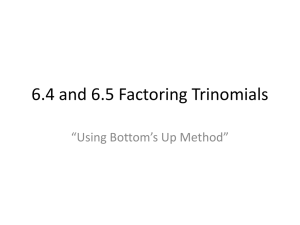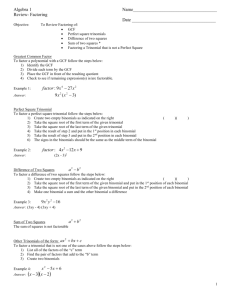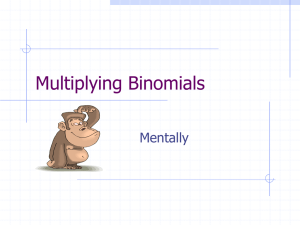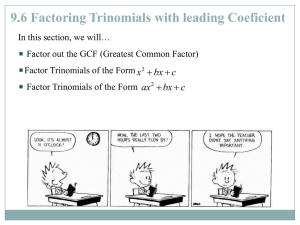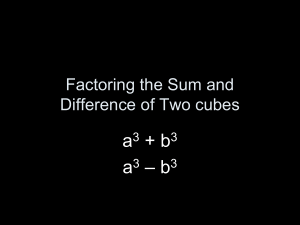Algebra 2
advertisement
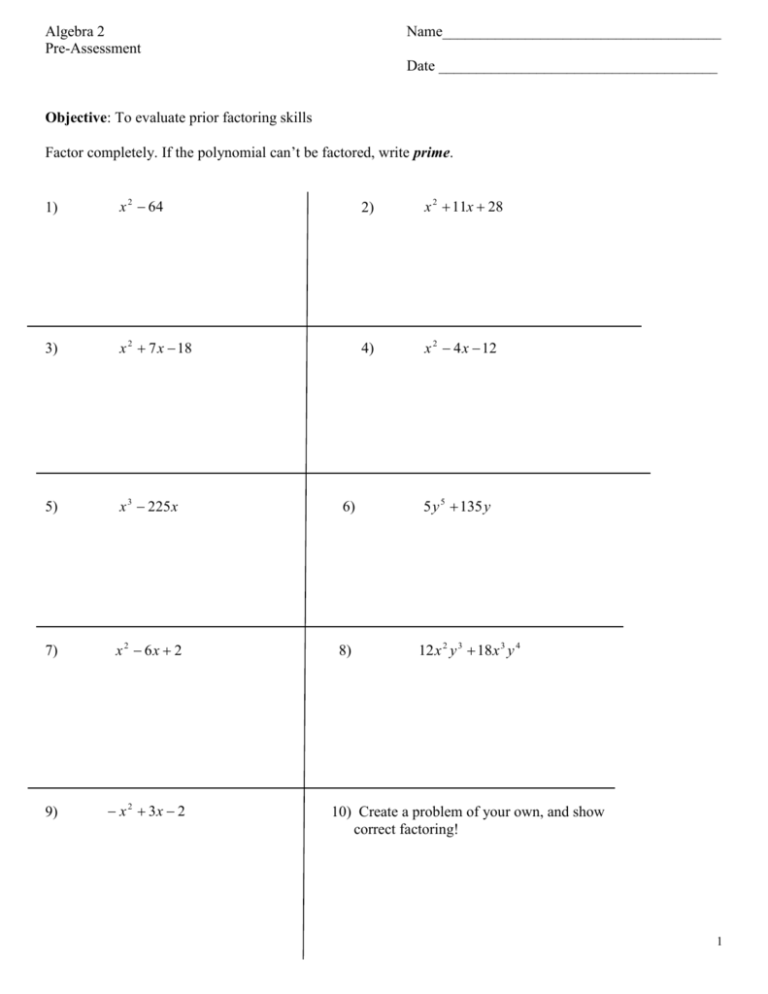
Algebra 2 Pre-Assessment Name_____________________________________ Date _____________________________________ Objective: To evaluate prior factoring skills Factor completely. If the polynomial can’t be factored, write prime. 1) x 2 64 2) x 2 11x 28 3) x 2 7 x 18 4) x 2 4 x 12 5) x 3 225 x 6) 7) x 2 6x 2 8) 9) x 2 3x 2 5 y 5 135 y 12 x 2 y 3 18 x 3 y 4 10) Create a problem of your own, and show correct factoring! 1 Algebra 2 Vocabulary- Unit 1 Name_____________________________________ Date _____________________________________ Objective: To know the definitions of the key vocabulary words/terms/phrases in the Functions Unit. To understand the difference between an object and a process as they apply to the Functions Unit. In General Object As it applies to mathematical concepts In General Process As it applies to mathematical concepts 1. Classify each of the following words as an object and/or the result of a process. 2. What should be the expectation of the term as an object and/or the result of a process. Example: Root of a quadratic: Noun- The points at which a function crosses the x-axis Verb- The solution of a quadratic equation when set equal to 0. Graph Axes x-intercept y-intercept Coordinates Abscissa 2 Ordinate Independent variable Dependent variable Slope Symmetry Axis of Symmetry Root of a number Parabola Operation Polynomial Rational Expression Vertex 3 Algebra 2 Lesson- Factoring Perfect Square Trinomials Name_____________________________________ Date _____________________________________ Objective: To discover patterns within perfect square trinomials. Factor the following, noticing any patterns that arise. Use the space at the right to record your observations. 1. x 2 8 x 16 ( )( ) 2. x 2 16 x 64 ( )( ) 3. x 2 12 x 36 ( )( ) 4. x 2 10 x 25 ( )( ) Notes: Use the patterns you recognized in the problems above to factor the more difficult problems below. Define and then summarize the procedure for factoring perfect square trinomials in the right margin. 5. 16 x 2 8 x 1 ( )( ) 6. 9x 2 6x 1 ( )( ) 7. 4 x 2 20 x 25 ( )( ) 8. 16 x 2 24 x 9 ( )( ) 9. 9 x 2 30 x 25 ( )( ) Fill in the blanks so that each expression is a perfect square trinomial, then factor. 10. x 2 18x __________ ( )( )( )2 11. x 2 __________ 121 ( )( )( )2 12. 9 x 2 __________ 36 ( )( )( )2 13. ________ x 2 20 x 25 ( )( )( )2 14. 49 x 2 28x ________ ( )( )( )2 Think about it… Why is the last term of a perfect square trinomial always positive? 4 Algebra 2 Lesson- Factoring Sum and Difference of Cubes Name_____________________________________ Date _____________________________________ Objective- To learn how to factor the sum and difference of perfect cubes. Do Now: Multiply and combine like terms: 1. Multiply: (x +2)(x2 - 2x + 4) 3. Multiply: (x - 2)(x2 +2x + 4) 2. Multiply: (x +3)(x2 - 3x + 9) 4. Multiply: (x - 4)(x2 +4x + 16) Now try these: 5. Multiply: (a +b)(a2 - ab+ b2) 6. Multiply: (a - b)(a2 + ab + b2) Using the examples above, determine the rule for factoring the following: Sum of 2 cubes: a3 + b3 Difference of 2 cubes: a3 - b3 5 Factor completely: 1. x3 – 27 2. 64x3 + 1 3. 27x3 – 8y3 4. 3x3 + 192 5. 3x3 + 81 6. 1 – 125b3 7. 2x3 – 128 8. 8x3 y6+ 27 9. a3b6– b3 10. Create a problem of your own, and show correct factoring! 6 Algebra 2 Lesson- Factoring by grouping Name_____________________________________ Date _____________________________________ Objective: Use grouping to factor polynomials. Do Now: Factor the following expressions completely. State the type of factoring method(s) you used. a) 64 x 2 676 b) a 2 5a ab c) 8 6y y2 Factoring trinomials where a 1 Notes: Ex: 2 x 2 11x 21 What are the possibilities for the first term in each binomial? Ex: 3 x 2 24 x 45 What should you check for first? Ex: 3 x 2 5 x 2 What are the possibilities for the first term in each binomial? What are the possibilities for the last term in each binomial? 7 Practice: Ex: 2 x 2 5 x 3 Factoring by Grouping – How is this problem different? Ex: x 2 2 x xy 2 y Notes: Sometimes you have to regroup first. Ex: 3a 2 2b 6a ab Factoring by Grouping to factor trinomials where a 1 and guess and check is more difficult Ex: 5 x 2 13x 6 Notes: More practice: 5 x 2 13x 6 9x 2 6x 8 8 Algebra 2 Review- Factoring Name_____________________________________ Date _____________________________________ Objective: To Review Factoring of: Perfect square trinomials Difference of two squares Sum of two squares * Difference of two cubes Sum of two cubes Factoring by grouping Factoring a Trinomial with Leading Coefficient not = 1 in the form ax2+ bx + c Perfect Square Trinomial To factor a perfect square trinomial follow the steps below: 1) Create two empty binomials as indicated on the right 2) Take the square root of the first term of the given trinomial 3) Take the square root of the last term of the given trinomial 4) Take the result of step 2 and put in the 1st position in each binomial 5) Take the result of step 3 and put in the 2nd position in each binomial 6) The signs in the binomials should be the same as the middle term of the binomial Example 1: Answer: ( )( ) factor : 4 x 2 12 x 9 (2x - 3)2 a b Difference of Two Squares To factor a difference of two squares follow the steps below: 1) Create two empty binomials as indicated on the right ( )( ) 2) Take the square root of the first term of the given binomial and put in the 1 st position of each binomial 3) Take the square root of the last term of the given binomial and put in the 2 nd position of each binomial 4) Make one binomial a sum and the other binomial a difference 2 2 Example 2: 9 x y 16 Answer: (3xy - 4) (3xy + 4) 2 2 a b Sum of Two Squares The sum of squares is not factorable 2 2 Sum of Two Cubes To factor a sum of two cubes follow the steps below: 1) Create an empty binomial and an empty trinomial as indicated on the right ( )( ) 2) Take the cube root of the first term of the given expression and put it in the 1 st position in the binomial. Square it and put it in the first position of the trinomial. **note- ignore all signs until the last step** 3) Take the cube root of the last term of the given expression and a. put it in the 2nd position in the binomial b. square it and put it in the last position of the trinomial 4) Find the product of the terms in the binomial and put it in the middle position of the trinomial 5) Arrange the signs as follows ( + )( − + ) Example 3: 8 x 3 27 (2x + 3) (4x2 - 6x + 9) Difference of Two Cubes The only difference between a difference of two cubes and a sum of two cubes is the sign arrangement. Arrange the signs as follows ( − )( + + ) 9 Example 4: 64 z 6 x 3 (4z2 - x) (16z + 4xz + x2) Factoring by Grouping Steps: 1) Find a convenient point in the polynomial to partition 2) Factor within each group 3) Factor across the groups Example 5: ( x3 + 7x2 ) + ( 2x + 14) x2( x + 7) + 2(x + 7) (x+7) (x2 + 2) Factoring a Trinomial with Leading Coefficient not = 1 in the form ax2+ bx + c Steps: 1) Multiply the a term by the c term 2) Find the factors of (ac) which will add to the b term 3) Rewrite the b term as the sum of two x terms with coefficients being the factors of (ac) 4) Group the first two terms and the last two terms each in a set of parentheses 5) Factor out greatest common factor from each group Example 6: 2x3 + x2 + 8x + 4 (2 x3 + x2 ) + (8x + 4) x2( 2x + 1) + 4(2x + 1) (2x + 1) (x2 + 4) 10 Algebra 2 Lesson- Simplifying Rational Expressions & Undefined Rational Expressions Objective- Name_____________________________________ Date _____________________________________ To learn how to reduce rational expressions to lowest terms. Do Now: On your calculator, graph the following: For each one, find the values of x for which the function is undefined (Hint: Look for the y-value showing as “ERROR”) Values of x for which the function is not defined: 1. 2. 2 x 5 y x 1 y 3. y 7x 2x 1 __________ __________ __________ Using the examples above, can you determine a way to find the values of x without graphing? 1. y 2 x 2. y 5 x 1 3. y 7x 2x 1 Now try these: (Find the value of x that makes the expression undefined): 4. 2x 1 2x 4 5. x2 2 x2 x 2 Note: Factor the denominator, set it = to zero, and solve the equation 6. 3x 4 3x 2 x 4 11 Reducing a rational expression - to reduce (or simplify) a rational expression means to write the answer in lowest terms. To do this, factor the numerator if it can be factored, factor the denominator if it can be factored, and then cancel any like factors. Examples. Reduce to lowest terms: 1. x4 3 x 12 2. x 2 3x 4 x 1 3. x2 9 x3 4. 2x x 2 x2 x 2 5. x 2 2x 3 x 2 5x 4 6. x 2 y xy2 xy 7. 212 4a a a 12 x 4 2x3 x 2 8. x3 x2 x 1 Now put it all together: 1) Determine the value(s) that make the following rational expressions undefined. Then simplify each. x x2 9 a) b) 3 x 16 x x3 12 Algebra 2 Lesson- Operations with Rational Expressions Name_____________________________________ Date _____________________________________ Objective: To know how to Add, Subtract, Multiply and Divide Rational Expressions DO NOW: Factor each rational expression completely: a) h 2 2h 3 h2 9 Suppose that we wanted to multiply those rational expressions: b) h 2 5h 6 h2 1 h 2 2h 3 h 2 5h 6 h2 9 h2 1 How could we use the simplified form of the fractions to do that? Multiplying Rational Expressions: Steps: Factor each numerator and denominator completely Cancel any like factor in any numerator with any like factor in any denominator Multiply the remaining expressions in each numerator Multiply the remaining expressions in each denominator Reduce if possible Examples: 1. y2 y y2 4 y 2 y 2 3y 2. 2 x 2 10 x x 2 5 x 6 x 2 2 x x 2 2 x 15 3. 2(a b) 2 4( x y ) 3( x y ) 3( x y ) 2 9(a b) 7(a b) 13 Now try this: x2 x2 8x 4x What is the new step that you need to remember to do when dividing? Dividing Rational Expressions: Steps: Multiply the first fraction by the reciprocal of the second (KCF) Continue using the rules for Multiplying Rational Expressions: Examples: 1. b2 1 2 b 9 3b 2. 3. Divide 2 x 6 x 6 x 2 x by 4 3 2 2 x 2 3x 2 2 x 2 7 x 3 x 2 3x x 3 3x 2 x 1 14 Adding and Subtracting Rational Expressions Steps: Factor all denominators Find the least common denominator among all fractions (if none already exists) Multiply each denominator and denominator by an appropriate factor to make it equivalent to the LCD Combine all numerators (make sure the signs are placed appropriately), simplify and put over LCD Reduce if possible Combine each set of rational expressions and simplify. Examples 1. 8x 4 4x 6 2x 6 2x 6 2. x 2x 2 2 x 3 x 2x 3 3. x 2 2 x x 6 x 5x 6 4. x 2y 6x y 2 3 x 12 y x 3 xy 4 y 2 5. 2x 1 4 2 x 5 x 3 x 10 2 15

